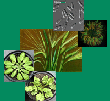| Silva, B; Dislich, C; Voss, I; Roos, K; Scheibe, R; Vorpahl, P; Schroeder, B; Huth, A; Beck, E; Bendix, J: Climate Change and its Impact on Current and Future Vegetation Dynamics and Carbon Cycling. In: Bendix J., Beck E., Bräuning A., Makeschin F., Mosandl R., Scheu S. and Wilcke W. (eds): Ecosystem Services, Biodiversity and Environmental Change in a Tropical Mountain Ecosystem of South Ecuador., Ecological Studies, Springer Berlin, Heidelberg, New York, Vol. 221 (2013), doi:10.1007/978-3-642-38137-9_24 | |
| Abstract: In this chapter, pasture and forest productivity and dynamics are investigated under global climate change impacts. Due to unsustainable management, pasture areas, mostly covered by Setaria sphacelata, are invaded by the aggressive Southern Bracken (Pteridium arachnoideum). The Southern Bracken Competition Model (SoBraCoMo) was applied to predict the development of the pasture-weed competition under IPCC-SRES A1B conditions. The model and respective physiological observations reveal an equal gain in performance of Setaria and bracken under global warming. In the forest, a potential increase in precipitation could boost landslide activity and thus affect growth dynamics. The forest-gap FORMIND model predicts a higher fraction of early successional species in tree species composition, which would reduce the aboveground carbon stocks. In summary, climate warming might not only improve regulating and supporting services on the pasture side (increased carbon sequestration, higher pasture yield), but also lead to a reduction of aboveground carbon stocks in the natural forest. |

